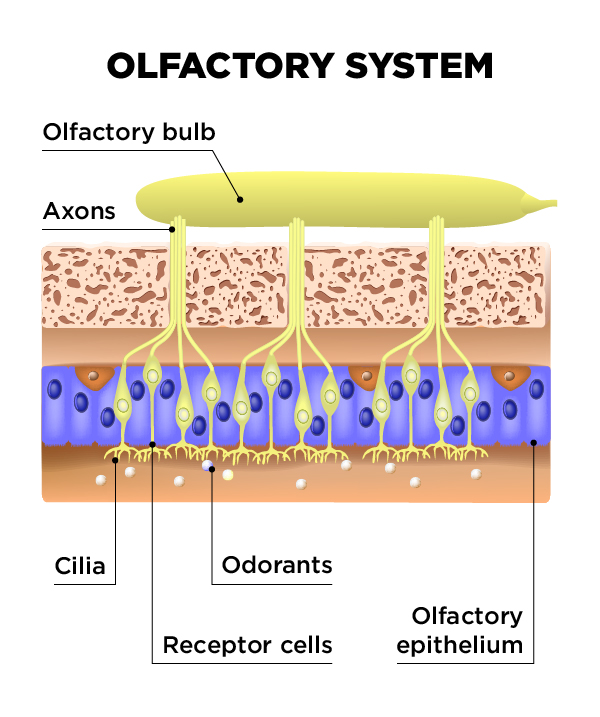Sarah lost her sense of taste for a month while Leila reports that after five months she still cant taste some things like alliums or Earl Grey tea. Pear-shaped structures in which receptor-bearing cells surround a central pore.

Our Sneaky Senses Science World
The origins of our sense of taste stretch back 500 million years when creatures developed the ability to sense prey in the ocean around them devour and appreciate it.
. Different types of papillae are found in different regions of the tongue. Another chemosensory mechanism called the common chemical sense involves thousands of nerve endings especially on the moist surfaces of the eyes nose mouth and throat. Because the characteristics of taste receptor cells are genetically determined people vary in their ability to taste some molecules.
Detecting a taste gustation is fairly similar to detecting an odor olfaction given that both taste and smell rely on chemical receptors being stimulated by certain molecules. As previously mentioned five different taste sensations are currently recognized. The tongue is covered with small bumps called papillae which contain taste buds that are sensitive to chemicals in ingested food or drink.
Hot flavors come from other chemicals such as in chili peppers and black peppers. Taste quality is just one way that you experience a certain food. The primary organ of taste is the taste bud.
Something that affects your sense of smell can also affect your taste. This depolarizes the cells leading them to release neurotransmitter. Both smell and taste use chemoreceptors which essentially means they are both sensing the chemical environment.
The other primary chemical sense taste technically the gustatory system responds to molecules dissolved in liquid. The sweet bitter and umami are produced by interaction of taste molecules with specific membrane receptor proteins coupled to G-proteins. Taste as a sense is the perception of a combination of these chemical signals on the tongue While it sounds simple taste involves so much more than these four simple categories that we learned.
Sweet - usually indicates energy rich nutrients. It activates the cell by changing specific proteins in the wall of the sensory cell. When stimulated these cells send signals to specific areas of the brain which make us conscious of the perception of taste.
Scientists in the nineteenth century were able to come to establish that there are four primary tastes that can be classified by chemical makeups. As can be predicted sugars are sweet salts or ionic molecules are salty alkaloids are bitter and acids are typically sour. There are millions of receptors onsome 10000 taste buds.
Despite this complexity five types of tastes are commonly recognized by humans. The sense of taste is equivalent to excitation of taste receptors and receptors for a large number of specific chemicals have been identified that contribute to the reception of taste. The primary organ of taste is the taste bud.
Your sense of taste can be affected by your age an infection medicine youre taking or other things. The gustatory system allows animals to distinguish between safe and harmful food and to gauge foods nutritional value. Digestive enzymes in saliva begin to dissolve food into base chemicals that are washed over the papillae and detected as tastes by the taste buds.
Phenylthiourea papers for example taste bitter to seven out of ten people and sodium. The sense of taste requires the activation of gustatory receptors on the tongue which receive innervation from cranial nerves VII IX and X and recognize the five taste modalitiesthat is sweet bitter salty sour and umami. Generally sweet and salty tasting chemicals.
Tastants chemicals in foods are detected by taste buds which consist of special sensory cells. As the Na concentration becomes high outside the taste cells a strong concentration gradient drives their diffusion into the cells. To this day the five basic.
The first salty is simply the sense of Na concentration in the saliva. Most organic molecules but particularly sugars taste sweet to varying degrees when they bind to G-protein coupled receptors on the taste cells. Taste papers see Supply List are small strips of paper impregnated with chemicals that test for perception of discrete tastes.
Detecting a taste gustation is fairly similar to detecting an odor olfaction given that both taste and smell rely on chemical receptors being stimulated by certain molecules. Salty flavors obviously come from anything with salt such as chips or nuts. The perception of flavors is complex and involves the senses of taste and smell as well as chemesthesis.
The chemical substance responsible for the taste is freed in the mouth and comes into contact with a nerve cell. Meaty flavors come from anything with glutamates such as soy sauce cheese and meat. Cool flavors come from certain chemicals such as in mint and menthol.
In humans the different types of taste cells are scattered throughout the tongue. These molecules enter the system via taste buds. This chemoreception in regards to taste occurs via the presence of specialized taste receptors within the mouth that are referred to as taste cells and are bundled together to form taste buds.
This change causes the sensory cell to transmit messenger substances which in turn activate further nerve cells. Up to 24 cash back The Chemistry of taste. Describe the common mechanism of action of molecules that taste sweet umami and bitter.
Taste and smell are separate senses with their own receptor organs yet they are intimately entwined. The taste buds contain specialized gustatory receptor cells that respond to chemical stimuli dissolved in the saliva. The tongue is covered with thousands of small bumps called papillae which are visible to the naked eye.
5 4 Tasting Smelling And Touching Introduction To Psychology 1st Canadian Edition

What Are The 5 Basic Tastes Everything About Umami Umami Ajinomoto Group Global Website Eat Well Live Well
0 Comments